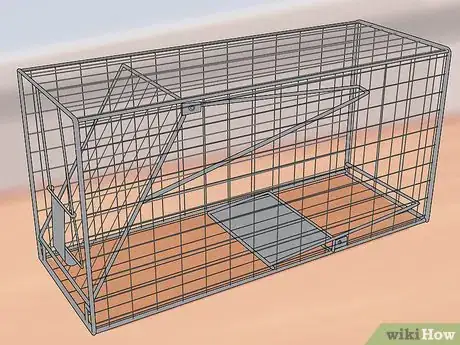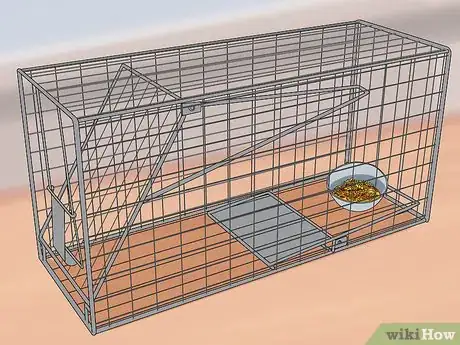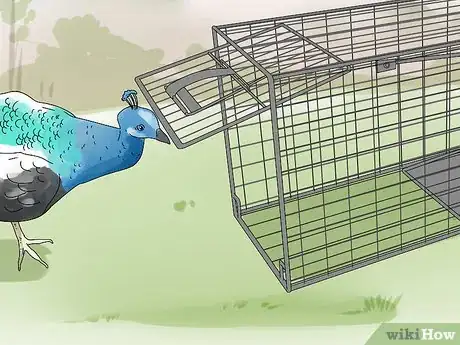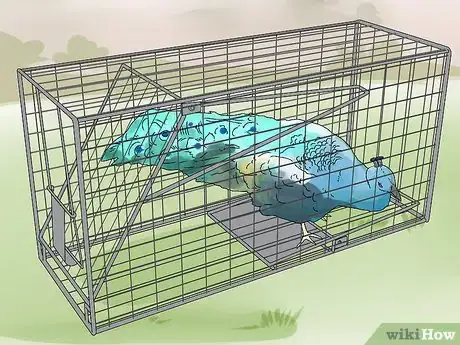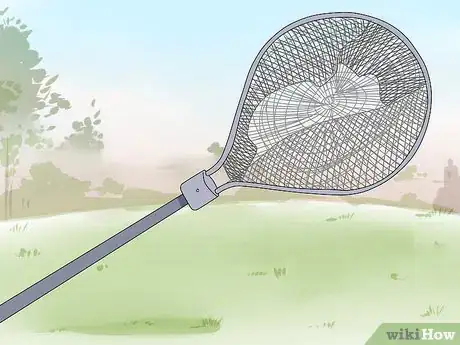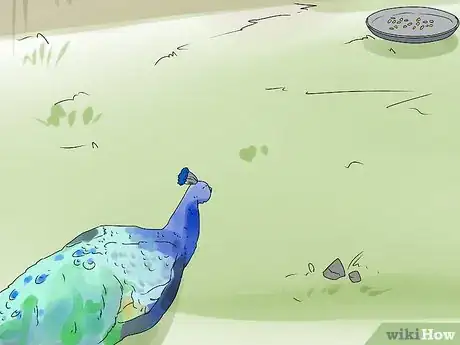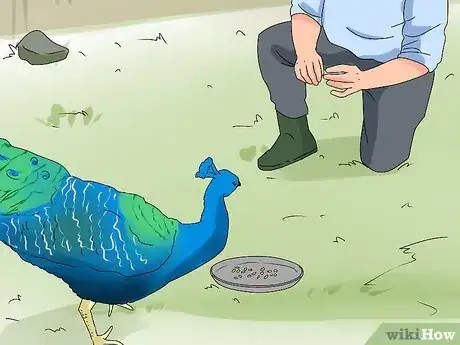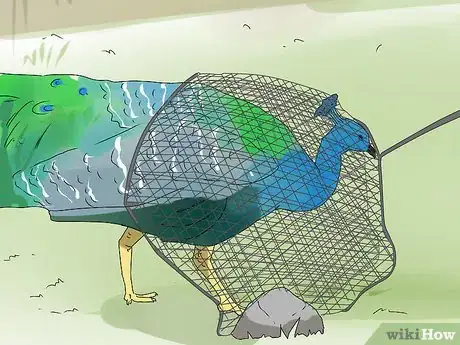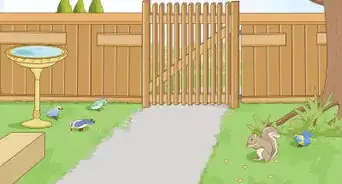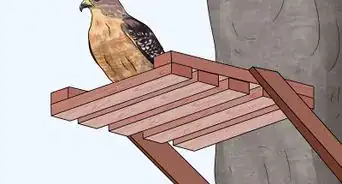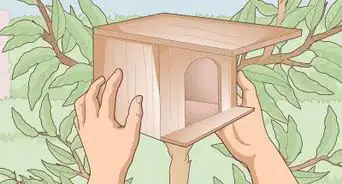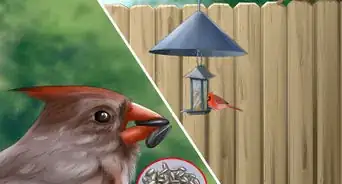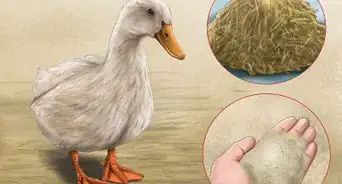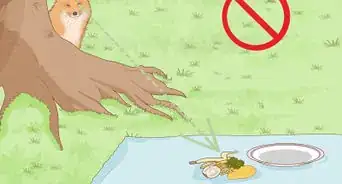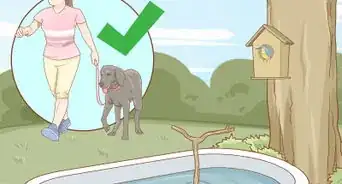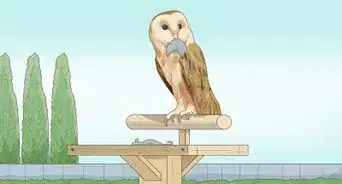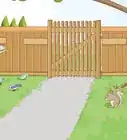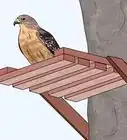This article was co-authored by wikiHow Staff. Our trained team of editors and researchers validate articles for accuracy and comprehensiveness. wikiHow's Content Management Team carefully monitors the work from our editorial staff to ensure that each article is backed by trusted research and meets our high quality standards.
This article has been viewed 38,415 times.
Learn more...
Stunningly beautiful as they may be, peacocks can be a bit of a nuisance. For starters, these truly big birds tend to make a lot of noise, especially at night when they roost. They also like to scratch around in your yard, ruining flower beds and making a mess as they scavenge for food. If you’ve had enough of a pesky peacock, you might try to catch it and relocate it to the wild. A wild peacock can get agitated easily when you approach it, so you need to catch it carefully to avoid injury to the bird and to you.
Steps
Catching a Peacock in a Cage
-
1Buy a cage specifically designed for trapping peacocks. A trap is one way to catch a peacock. You can use a trap in a small area like a backyard or patio. The trap has a door that you can prop up with a stick for the peacock to enter and release quickly once it's inside. A properly designed trap has space for the peacock's tail to spread.
- You might be able to find a peacock trap at your local farm supply store.
- Contact your local animal control center to find out if they have a peacock trap you can borrow.
-
2Place the food deep inside the trap. Peacocks tend to be jumpy, so if you place the food at the edge of the trap, the peacock may grab it and run away. Peacocks love scavenging for food, though. In addition to insects, worms and small snakes, they love to eat:
- Birdseed
- Tasty food scraps
- Cereal grains
Advertisement -
3Allow the peacock to find the food inside the cage. This may take patience. The best way to capture a peacock successfully is to let it find the food you placed in the cage on its own. The great thing about peacocks is that they have great eyesight and they don't like working hard to find food. In short, if you put food in a trap for them, they’ll see it. [1]
-
4Trap the peacock. Once the peacock is in the cage enjoying the food, quickly but quietly approach the cage from behind. Release the trap door by removing the stick propping it open and let the door drop closed. Let the peacock calm down as it will be agitated once it realizes it has been captured.
- Removing a peacock in a trap is as simple as picking up the trap and carrying it to your vehicle.
- Place several layers of newspaper or a tarp on the floor of your vehicle. This makes clean up easy if necessary.
- You might throw a blanket over the cage to help the peacock stay calm during transport.
Catching a Peacock with a Fishing Net or Blanket
-
1Get a large landing net or an old blanket. A landing net, commonly used by fishermen, looks like a cone and has a long handle. Catching a peacock with a landing let or blanket requires physical strength and bravery. This is because, eventually, you need to engage the peacock head-on to actually catch it, pick it up in your arms, and put it in a box or cage. [2] Like most other birds, peacocks get sleepy in darkness, so gently tossing a blanket over them can stop them in their tracks.
- Shop for a landing net at your local fishing store.
-
2Place food in the area where you want to catch the peacock. In a small yard, it might make sense to place the food in the middle of the yard to avoid damaging flower beds and personal belongings. In a larger space, it might make sense to place food for the peacock in a corner.
- Consider asking a buddy to help you catch a peacock using a fishing net or blanket. One of you can toss the net or blanket over the peacock and the other can get ahold of its legs and pick it up once it calms down. [3]
-
3Approach the peacock quietly as it eats. Think cartoon depictions of characters tiptoeing up on one another. That’s what you need to do. Make sure you’re ready to move quickly to throw the net or blanket over the bird.
- If the peacock senses your presence and tenses up, consider backing off for a few moments. An agitated peacock can fly away fast or make other sudden movements that might injure you or it.
-
4Toss the fishing net over the peacock's head and breast. Bring it to the ground gently and hold the net in place. The startled peacock will be agitated at first, but it will calm down after a few moments. Then, hold both the peacock’s legs together with your left hand and pick it up under your right arm. Place it in a box or cage for transport. [4]
- Holding the peacock’s legs together and tucking the bird under your arms ensures that it won’t injure itself or you. [5]
- Should you toss a blanket over a peacock, it will be similarly agitated for a few moments and then calm down. Then, lift up the blanket from the back, keeping the peacock's head covered. Hold both legs together and tuck the bird under your arms.
Community Q&A
-
QuestionWhy would you do this peacocks?
 PavoKeeper18Community AnswerSometimes wild/roaming peafowl can cause problems, as they are known to defecate on roofs and create a lot of noise. Don't worry, peafowl can be relocated ethically and safely to a place where they will be happier - in the end, both peafowl and human can both be happy and win with the right care.
PavoKeeper18Community AnswerSometimes wild/roaming peafowl can cause problems, as they are known to defecate on roofs and create a lot of noise. Don't worry, peafowl can be relocated ethically and safely to a place where they will be happier - in the end, both peafowl and human can both be happy and win with the right care. -
QuestionWhy are you teaching this to people? It is bad to hurt animals.
 NowUknowCommunity AnswerSometimes the peacocks are in danger of humans from things like road traffic or other animals; other times, they can be loud and annoying. Catching a peacock is not hurting it or bad, it is simply moving it where it can be safer or where it isn’t being quite so disruptive.
NowUknowCommunity AnswerSometimes the peacocks are in danger of humans from things like road traffic or other animals; other times, they can be loud and annoying. Catching a peacock is not hurting it or bad, it is simply moving it where it can be safer or where it isn’t being quite so disruptive.
Warnings
- Wait until the peacock is totally focused on eating before you approach it. If you scare it, it can get agitated and cause serious injury to itself or you if you’re too close.⧼thumbs_response⧽
References
- ↑ https://sciencing.com/peacock-food-4671901.html
- ↑ https://www.roysfarm.com/how-to-catch-a-rooster/
- ↑ https://www.birdtrader.co.uk/how-to-catch-a-peacock-on-the-loose/
- ↑ http://www.browfarm.co.uk/peafowl/peafowl-information/catching-transporting-peafowl/
- ↑ https://nypost.com/2012/09/01/runaway-peacock-finally-captured-and-returned-to-queens-school/
